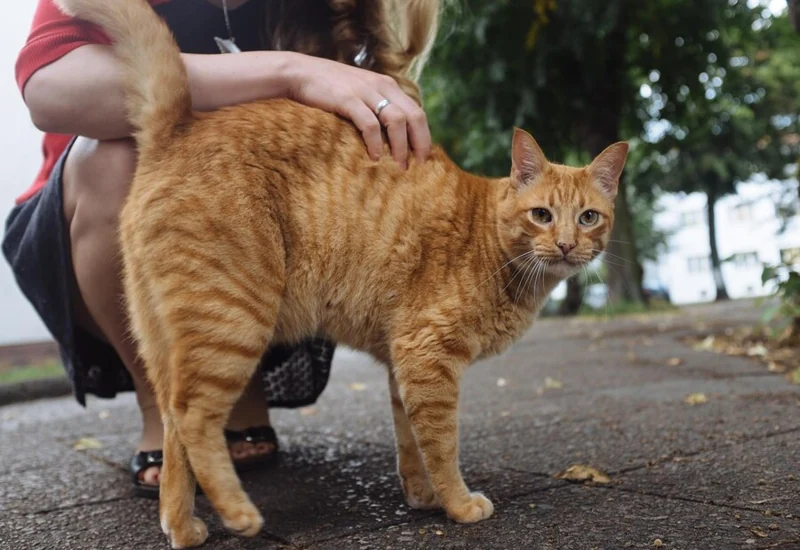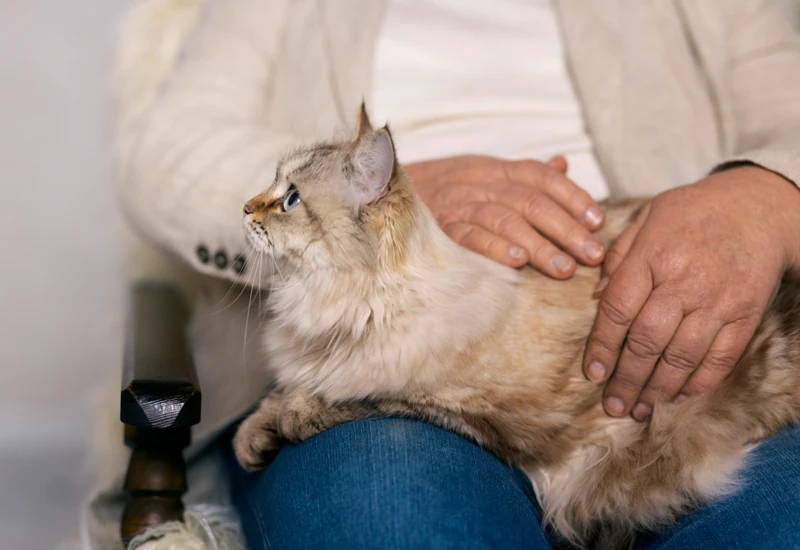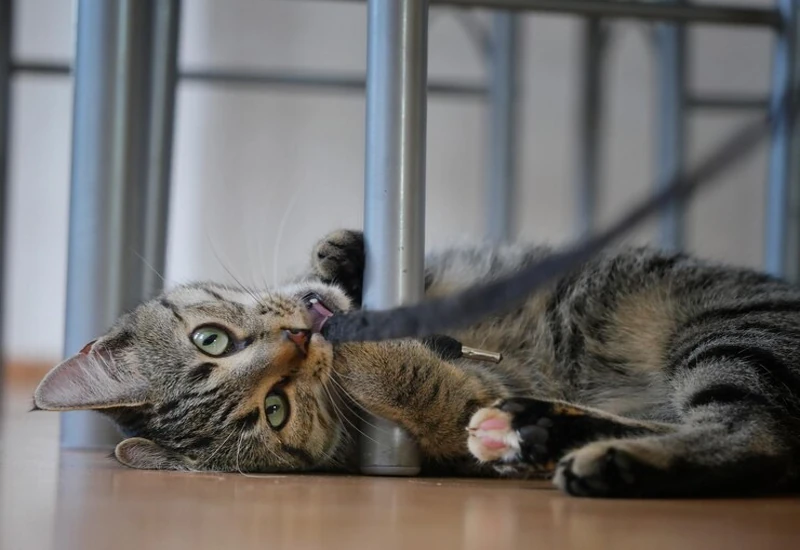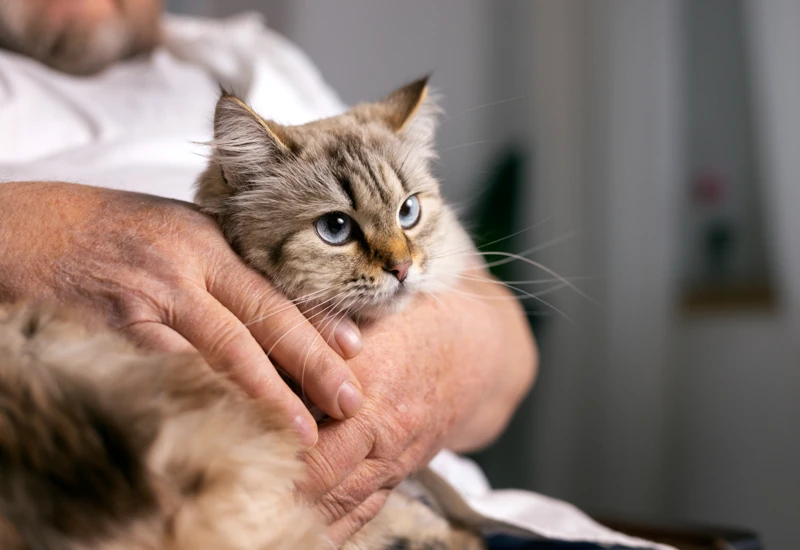Should I Euthanize a Paralyzed Cat? Causes, Symptoms and Treatment
Updated: 28 May 2024
523

“Should I euthanize a paralyzed cat?” is a question that brings a flood of emotions. The answer isn’t straightforward, as it depends on various factors like your cat’s quality of life, their overall health, and your ability to provide long-term care.
This guide aims to help you navigate this challenging situation. We’ll explore the causes of paralysis in cats, symptoms, diagnosis, treatment options, and alternatives to euthanasia.
Our goal is to provide you with comprehensive information to make an informed decision that prioritizes your cat’s well-being and your peace of mind. Remember, you’re not alone in this journey, and it’s okay to seek help and advice from a veterinarian.
Age-Wise Detailed Guide for Paralyzed Cats
| Age of Cat | Veterinary Care Frequency | Physical Therapy Frequency | Special Diet Needs | Potential Treatments | Caring Tips |
|---|---|---|---|---|---|
| Kitten (0-1 year) | Monthly | Daily | High-protein diet | Gentle physical therapy, medications as prescribed by vet | Monitor closely, provide a safe environment, handle gently |
| Young Adult (1-3 years) | Every 3 months | Daily | Balanced diet | Continued physical therapy, possible surgical interventions | Regular exercise, mental stimulation, regular grooming |
| Adult (3-10 years) | Every 6 months | 3-5 times a week | Balanced diet | Adjustments to physical therapy routine, long-term management of symptoms | Regular health screenings, joint care, monitoring for behavior changes |
| Senior (10+ years) | Every 3 months | 2-3 times a week | Diet for senior cats | Management of any age-related conditions, comfort-focused care | Regular health screenings, joint care, monitoring for behaviour changes |
Factors to Consider When Deciding Whether to Euthanize a Paralyzed Cat

Your Cat’s Mobility and Quality of Life
When your cat becomes paralyzed, its ability to enjoy many activities is hurt. These include walking, playing, eating, and responding to commands. Paralysis can limit their mobility, making it difficult for them to move around and engage in activities they once enjoyed. This can lead to frustration and depression in your cat, affecting their well-being.
The impact of paralysis on your cat’s independence can also be significant. Cats are independent creatures, and losing the ability to move their back legs can be distressing for them. They may become reliant on you for basic needs, such as feeding and grooming, which can affect their quality of life.
Your Cat’s Declining Health
Paralysis can often be accompanied by other signs of declining health. These can include loss of appetite, incontinence, chronic pain, and constant whimpering. These signs can indicate that your cat is suffering and their quality of life is deteriorating.
Loss of appetite can lead to weight loss and malnutrition, while incontinence can lead to hygiene issues and skin infections. Chronic pain can make your cat withdrawn and less interactive. Constant whimpering can show distress.
You should consider the impact of these signs on your cat’s quality of life. They also affect your ability to provide care. Consider them when deciding whether to euthanize.
Your Ability to Provide Long-Term Care
Caring for a paralyzed cat can be physically, emotionally, and financially demanding. It requires a significant time commitment, as your cat may need help with feeding, grooming, and using the litter box. They may also need regular physical therapy and veterinary check-ups to manage their condition.
The emotional toll of caring for a paralyzed cat can also be significant. It can be distressing to see your beloved pet in pain and struggling with everyday activities. This can lead to feelings of guilt, sadness, and stress.
The cost of long-term care for a paralyzed cat can be substantial. This can include the cost of vet care, medicine, and therapy, which might be recommended by a veterinary medicine specialist. It also includes special equipment to help with movement. It’s important to consider whether you have the resources to provide this level of care in the long term.
You should also consider how these demands impact your own well-being and the potential for burnout. Remember that your health and well-being are important too, and you need to take care of yourself to be able to take care of your cat.
Causes of Paralysis in Cats

Traumatic Injury
Traumatic injuries, such as those from accidents or falls, can cause paralysis in cats. These injuries may damage the spinal cord, leading to partial or complete paralysis.
The severity of the paralysis often depends on the extent of the injury. For instance, a minor fall may result in temporary paralysis, while a severe accident could lead to permanent paralysis.
Infection in Bones or Tissue Near Spine
Infections in the bones or tissues near the spine can lead to paralysis. These infections can cause inflammation and damage to the nerves, resulting in loss of movement.
Bacterial or fungal infections are common culprits. They can be caused by an infected wound or spread from another part of the body.
Slipped Discs in the Back
Slipped discs, also known as herniated discs, can cause cat paralysis. The discs in the spine can slip out of place, putting pressure on the spinal cord and causing paralysis. This condition is often painful and can lead to significant mobility issues. It’s most common in older cats but can occur at any age.
Inflammation in Muscles Surrounding the Spine
Inflammation in the muscles surrounding the spine can lead to paralysis. This inflammation can pressure the spinal cord, leading to loss of movement. Conditions like myositis, an inflammation of the muscles, can lead to this issue. It can be caused by injury, infection, autoimmune diseases, or exposure to toxins.
Tick Paralysis
Tick paralysis is a condition caused by a toxin that some ticks can inject into a cat’s bloodstream when they bite. This toxin can affect the nervous system and lead to paralysis. The paralysis usually starts in the hind legs and moves forward to the front legs, neck, and face. It’s a serious condition that can be fatal if not treated promptly.
Tumors in the Spine or Brain
Tumors in the spine or brain can cause paralysis in cats. These tumors can pressure the spinal cord or brain, interfering with the signals that control movement. Both benign and malignant tumors can lead to paralysis. Symptoms can vary widely, depending on the location and size of the tumor.
Malformation of Spine or Vertebrae
Some cats may be born with malformations of the spine or vertebrae, which can lead to paralysis. These malformations can interfere with the normal functioning of the spinal cord. Conditions like spina bifida, where the spine doesn’t develop, can lead to paralysis in cats.
Certain Chemicals or Toxins
Exposure to certain chemicals or toxins, such as botulism, can lead to paralysis in cats. These substances can damage the nerves, leading to loss of movement. Botulism, for instance, is a toxin produced by bacteria that can cause paralysis if ingested.
Embolism
An embolism, or a blockage in the blood vessels, can cause paralysis in cats. If the blockage occurs in a blood vessel that supplies the spinal cord, it can lead to paralysis. This is a medical emergency that requires immediate veterinary attention.
Symptoms of Paralysis in Cats

Inability to Use or Move Portions of the Body
One of the most obvious symptoms of paralysis in cats is the inability to use or move certain body parts. This can range from difficulty moving a single limb to complete paralysis of the entire body. The affected area may also feel cold to the touch, and the cat may not respond to touch or pain in that area.
Improper or Stumbling Gait
Cats with paralysis may have an improper or stumbling gait. They may drag their hind legs, have difficulty standing, or fall over while trying to walk. This is often one of the first signs of a cat experiencing paralysis.
Difficulty Breathing
Paralysis can sometimes affect the muscles involved in breathing, leading to difficulty breathing. This can be a serious symptom that requires immediate veterinary attention. Cats with this symptom may breathe rapidly, have a blue tint to their gums, or appear anxious or panicked.
Uncontrolled Twitching
Uncontrolled twitching or tremors can be a symptom of paralysis in cats. Damage to the nerves that control muscle movement can cause this. The twitching may be localized to one area or affect many parts of the body.
Extreme Slowness of Movement
Cats with paralysis may move much slower than usual. They may take longer to stand up, walk, or perform other movements. This can be a sign that the muscles are not receiving the proper signals from the brain or spinal cord.
Difficulty Eating or Drinking
Paralysis can make it difficult for a cat to eat or drink. They may have trouble chewing or swallowing or be unable to reach their food or water dish. This can lead to weight loss and dehydration, which can further complicate the cat’s health.
Inappropriate Urination
Cats with paralysis may have difficulty controlling their bladder, leading to inappropriate urination. They may urinate outside the litter box or not be able to hold their urine, which can lead to urinary tract infections and other complications.
Dribbling of Urine
In severe cases of paralysis, cats may dribble urine. This can be due to a lack of control over the muscles that control urination. This symptom can lead to skin irritation and infection, and it can be distressing for both the cat and the owner.
Diagnosis of Paralysis in Cats

Physical Examination
A physical examination is often the first step in diagnosing paralysis in cats. The vet will check for signs of injury, pain, or abnormal movement. They may also check the cat’s reflexes and response to touch.
Manipulation of Individual Limbs
The vet may manipulate the cat’s limbs to check for signs of weakness or paralysis. This can help determine the extent and location of the paralysis. The vet may also check for signs of pain during this examination.
Pain Response Testing
Pain response testing can help determine if the cat has lost sensation in certain parts of its body. The vet may gently pinch or prick the cat’s skin to see if it reacts. A lack of response can cause nerve damage.
Basic Diagnostic Tests
Basic diagnostic tests, such as blood and urine panels, can help rule out certain causes of paralysis, such as infection or exposure to toxins. These tests can provide valuable information about the cat’s health and help guide the treatment plan.
Advanced Imaging
Advanced imaging techniques, like MRI, CT scan, or X-ray, can show the cat’s spine in detail. They can help find any problems causing the paralysis. These tests can reveal issues like tumors, slipped discs, or spinal cord damage.
Treatment Options for Paralyzed Cats

Medical Treatment for Infections
If an infection causes the paralysis, the cat may need medical treatment. This can include antibiotics or other medications to fight the infection. The vet may also recommend supportive care, such as fluids and nutritional support, to help the cat recover.
Anti-inflammatory Medications for Injuries
If the paralysis is due to an injury, the cat may need anti-inflammatory medications. These can help reduce swelling and pain, and may help improve mobility. Pain management is a crucial part of treatment for cats with paralysis.
Home Care and Exercises to Improve Comfort and Range of Motion
Home care and exercises can be an important part of treatment for paralyzed cats. This can include providing a comfortable and safe space. You can also help the cat with gentle exercises, which improve its range of motion. Regular movement can help prevent muscle atrophy and improve circulation.
Alternative Therapies
Other therapies, such as stretching, massage, acupuncture, and laser therapy, can also help. They can improve mobility and comfort in paralyzed cats and can be used in conjunction with traditional treatments to provide a comprehensive care plan.
Surgical Interventions
In some cases, surgical interventions may be necessary. This can include surgery to remove tumours, correct malformations, or relieve pressure on the spinal cord. The decision to pursue surgery will depend on the cat’s health, the cause of the paralysis, and the potential benefits and risks of the procedure.
When Euthanasia May Be the Best Option
Signs that euthanasia may be needed include no appetite, loss of bladder control, chronic pain, and constant whimpering. The impact of these signs on your cat’s quality of life and your ability to provide care should be considered.
The decision to euthanize your paralyzed cat is a personal one and should be made after considering all factors, such as the cat’s quality of life and your ability to provide long-term care.
What Should You Do if You Don’t Want to Euthanize Your Paralyzed Cat?
If you decide against euthanasia, it’s important to ensure that your cat has the best possible quality of life. This may involve changing your home. You may also need to get physical therapy or alternative treatments. You will also need to provide lots of love and care.
Conclusion
Deciding whether to euthanize a paralyzed cat is a personal and challenging decision. It involves considering your cat’s quality of life, their health, and your ability to provide long-term care.
It’s important to remember that you know your cat best, and it’s okay to seek support during this difficult time.
This guide has given you complete information covering the causes and symptoms of paralysis in cats. It also covers diagnosis, treatment, and alternatives to euthanasia. The decision should be about what’s best for your cat.
If you’re facing this decision, reach out to your vet or a pet loss support group. You don’t have to go through this alone. Remember, every step you take is a testament to your love and care for your feline friend.
Can paralyzed cats poop on their own?
Paralyzed cats often struggle with bowel movements and may require assistance to poop.
What to do with a paralyzed cat?
A paralyzed cat requires special care, including regular vet check-ups, physical therapy, a comfortable environment, and assistance with feeding and grooming.
Please Write Your Comments